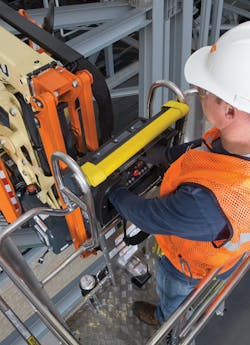Five Tips for Starting a Safety Program
Creating a culture of safety can be difficult and take time, but sometimes the key is simply finding the right way to start. Here are five important elements that must be present to establish a safety and health program, courtesy of JLG.
-
Employee Training and Empowerment
Before you can expect employees to follow best practices, you must educate them and empower them to hold each other accountable. Dedicate a day to safety training when you share safety tips and plan activities that keep your employees interested. There are plenty of online safety training ideas and resources to help get you started.
As far as accountability goes, consider implementing a policy such as stop-work authority, which gives any employee (regardless of job title) the ability to stop a task if it becomes risky. Putting safety in the hands of every worker can help you foster accountability at all levels of your organization.
-
Hazard Identification and Control Systems
Once your employees are trained, a safety-management process must be put in place for them to easily identify hazards and take steps to contain them. For example, if workers will use an aerial lift on a job site, hazards like power lines and uneven ground should be identified and addressed before any work is done. It’s true that not all hazards can be eliminated, but most can be controlled. For each hazard you identify, try following the hierarchy of controls to ensure you’ve done everything you can to keep workers safe on the job.
-
Focus on Compliance
Organizations like the Occupational Safety & Health Administration (OSHA) and the American National Standards Institute (ANSI) were created to keep workers safe and promote job site safety. They outline best practices for all types of jobs and, in the case of OSHA, each best practice is actually a law.
Complying with OSHA’s regulations is the best way to ensure you’re doing everything you can to keep your workers safe. They even provide compliance resources organized by industry as well as email newsletters and a searchable database by safety topic.
-
Continuous Improvement
Safety and health programs don’t fall into the “set it and forget it” category. Not only are new regulations being released all the time, but also remember that new employees will be joining your team. So it’s important to adopt a continuous improvement mindset when it comes to safety. Hold frequent safety meetings, retrain more tenured employees as you train new hires, and consider doing a full safety and health program audit each year.
Also, encourage employees to share their concerns with you. These concerns can most likely be turned into safety topics that will resonate with your entire team.
-
Leadership and Organizational Buy-in
For a safety and health program to be effective, there must be institutional buy-in from the top down. Workers will be faced with situations every day that force them to decide between a safe course of action and an unsafe one. Good safety leaders motivate workers to make the right decision—even when no one is watching.
Like all forms of leadership, becoming a good safety leader starts with honest, consistent communication. Set high but attainable standards for your team. Offer an incentive for following your organization’s safety-management system. And if an incident that requires disciplinary action occurs, always communicate the “why” along with the “what” when addressing it.
